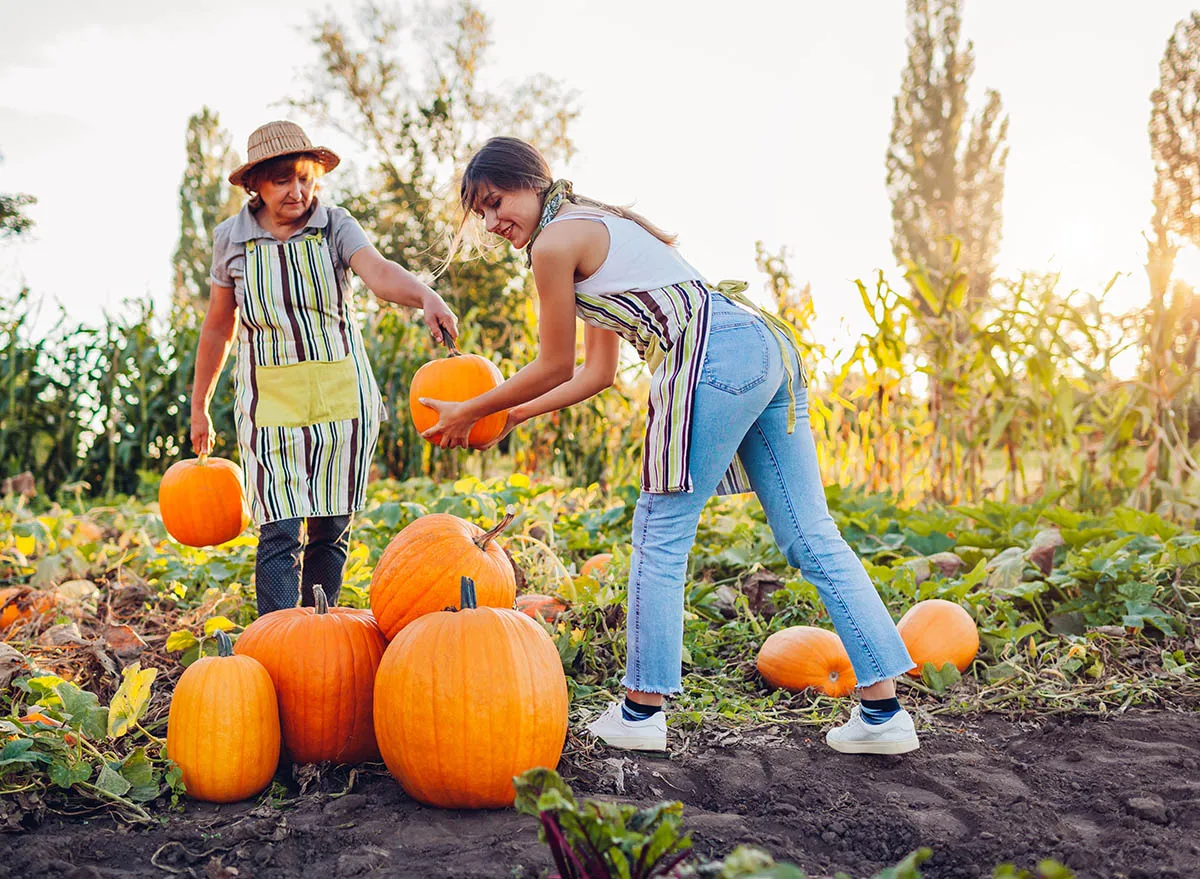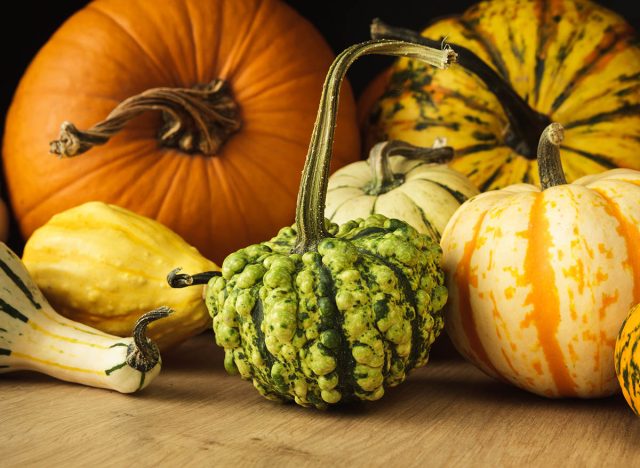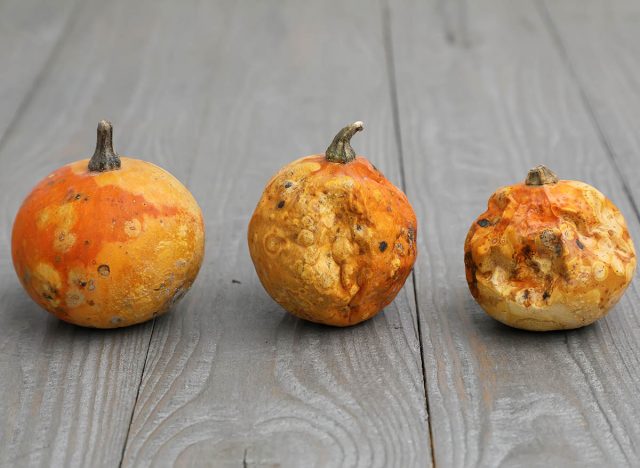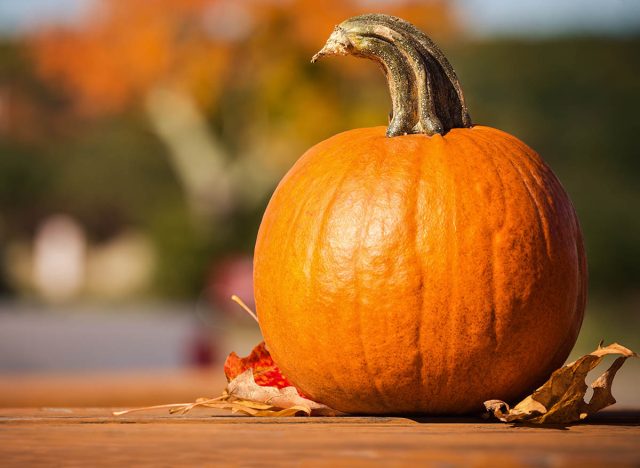9 Secrets To Choose the Best Pumpkin in the Pumpkin Patch

Although parting with summer can be such sweet sorrow, autumn follows suit, and there is so much excitement that is in store for this season. For starters, activities like apple and pumpkin picking are in full swing. While it's pretty standard for you to grab apples for eating, pumpkins are usually looked upon as gourds you get for carving and painting. However, you can actually harvest your own for cooking, too.
If you're already heading to the orchards for some seasonal festivities, why not pick up a gourd or two to take home and use for your autumnal recipes? Whether you're a first-timer when selecting fresh pumpkins or a seasoned pro (or seasonal pro, pun intended), there are ways to ensure you pick the perfect ones for cooking. Read on to see what professional chefs have to say about the secrets of choosing the best pumpkin. Then for more helpful tips, take a look at The Best and Worst Cuts of Meats to Buy, According to Butchers.
Know the varieties.

First things first, not all pumpkins are the same, which is why you need to decipher the ones best for cooking versus the best for carving.
"Certain varieties of pumpkin are edible while others are more decorative in nature— mainly gourds or pumpkins destined to be carved," says Olivia Roszkowski, chef-instructor of Health-Supportive Culinary Arts at the Institute of Culinary Education. "Edible pumpkins are part of the Cucurbitaceae family."
When deciding on a pumpkin to cook with and eat, Chef-instructor Roszkowski says there are dozens of varieties to choose from, including Sugar Pie, New England Cheddar, Long Island Cheese, Blue Doll, Porcelain Doll, Cinderella, Fairytale, Kabocha, Casper, and Cherokee Bush.
Size matters—the smaller the better.
Don't you find it adorable when kids try to pick up the biggest pumpkins in the patch and their bodies are just as big? You then end up carrying the pumpkins and feel like you just lifted weights at the gym. Well, put down the pumpkin kettlebells, because if you're cooking, then the smaller, the better!
"Smaller pumpkins will be easier to cut into and have a tendency to yield sweeter, juicier, and less starchy flesh," says Chef-instructor Roszkowski. "Cooking time will also be shorter."
There are also types of pumpkins that make for better cooking because of their size.
"For baking, look for pie pumpkins, which are significantly smaller in size, weighing in at 3 to 5 pounds," advises Bonnie Shuman, executive chef at Weavers Way Co-Op. "This type has more flesh on the inside and fewer seeds and is not as stringy."
Watch for bruises and rotting.
Have you ever been fruit-picking and seen decrepit apples or peaches rotted away on the branches or on the floor? Those aren't your ideal picks to take home, and the same goes for when you're choosing pumpkins to eat.
"When it comes to cooking, you'll want to make sure the pumpkin you pick isn't bruised," says Isabella Flint, professional chef and founder and CEO of Fanatically Food. "Let's be honest, many of these pumpkin patches have pretty huge footfalls. Even if a pumpkin hasn't been accidentally stepped on, which is likely, it could have been previously picked and then dropped or put back down. So, check for bruising visually, and make sure the entirety of the outer shell is hard."
To check the outer shell for any internal bruises, Chef Flint suggests using "the old-fashioned fingernail test." Scratch your fingernail onto the pumpkin. If you can't make a puncture or indentation in the pumpkin with your fingernail alone, the pumpkin is fine to eat.
"Bruises and other visible damage to the pumpkin, as well as invisible soft spots, are signs that rot has set in or is beginning to set in," she says, "and let me tell you, you do not want to be cooking with a rotten pumpkin."
Cathy Asapahu of Michelin Bib Gourmand LA restaurant, Ayara Thai, also advises checking underneath the pumpkins, as not all rotting will be immediately visible when you're searching through the pumpkin patch.
"Pumpkins can start to rot on their bottoms where they have been sitting on the ground too long so check the underside too," she says.
Know the difference between blemishes.

How many times have you gone to the pumpkin patch to find what you thought was the perfect pick, but turned it around to see a ton of imperfections? Instead of letting out a sigh of disappointment and laying it back down, you should determine if the blemishes are salvageable, as they may still be okay for cooking, dependent on the pumpkin's trauma.
"Check your pumpkin for blemishes such as nicks, cuts, and scars," says Chef Shuman. "These blemishes are indicators that the pumpkin is past its ripe stage for cooking and may be spoiled."
On the other hand, Chef-Instructor Roszkowski says if you see beauty marks like warts or bumps, then you're still good to pick them. "These rarely affect the taste of the interior flesh," she says.
Check if it's hollow.
You know that classic saying, "it's what's on the inside that counts?" Take that into consideration when choosing your gourd, because while they may look perfect on the outside, you're eating what's on the inside, and you definitely don't want to consume an internally rotten pumpkin.
"Just like watermelons, the best pumpkins to pick have a deep, hollow sound when you tap them," says Elena Dyulgerova, the Founder and CEO of VegeVega. "To test for a good one, hold the pumpkin with one hand, place your ear next to the pumpkin, and knock on its side with the knuckles of your other hand. If you hear an echoing, hollow sound, it's a good one. The louder the sound, the better the pumpkin."
Note the stem.

You're not going to bite off the stem and eat it like it's a piece of jerky. But, this stalk is a good indicator for harvesting.
"You'll want to make sure that you're picking a pumpkin that is still firmly attached to a healthy stem," says Chef Flint. "A strong, brown, and an (importantly) dry stem is a sign that a pumpkin is ripe and ready to be picked."
Check out the color.
When you envision a pumpkin, the first color you probably think of is orange. That picture-worthy look can easily be the symbol of all things fall, so it only feels right to select one for cooking that fits the mold.
"The ripest pumpkins will be those which hold their color all over, and if picking a field pumpkin, this color will be a dazzling, deep orange," Chef Flint suggests. "Spots of green or brown, for example, indicate a pumpkin which is damaged or unripe and should be avoided if you intend to cook with it."
But if you can't find that perfect deep orange pumpkin, don't panic! As long as you're in the color scheme, your pumpkin should still be good to go. That's because pumpkins continue to ripen as they sit out, according to Chef-instructor Roszkowski.
Use your nose.
Taste and smell go hand in hand when you eat, so it only makes sense for your nose to be involved in the pumpkin-picking process.
"When choosing the perfect pumpkin, looks can be deceiving but your nose is your best tool," says award-winning Chef David Kirschner, owner of dineDK, a luxury private dining company. "A ripe pumpkin should smell sweet and profoundly 'pumpkin-y.' No smell equals no flavor!"
Tip for at home: Don't let your pumpkin spoil.
You finally got your pumpkin from the patch! You chose one with the perfect color, a firm stem, a hollow interior, and all the other great qualities. The last thing you want to do now is let it go to waste.
"Some pumpkins spoil faster than others," warns Chef-instructor Roszkowski. "Do not leave it on your porch for weeks before cooking for best results."
Furthermore, she says that pumpkins usually last around one month but can potentially last up to three months in cool storage or non-humid conditions. However, just to be on the safe side, use a pumpkin within one week of cutting into it….and don't even think about carving it if you intend to eat it later on!









